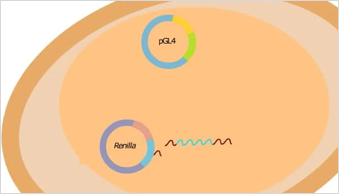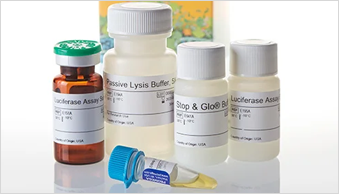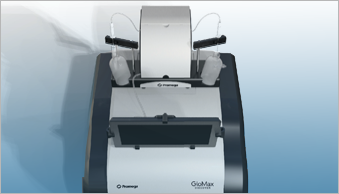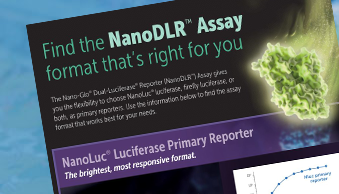Choosing a Luciferase Reporter Assay
A reporter assay comparison guide.
This guide will help you learn about reporter assays and find the one best suited for your needs. Visit the Promega catalog listing to view ordering information for the Reporter Assays featured here.
Reporter Genes and Assay Chemistries
When creating a luciferase reporter assay, there are two important elements to consider: the luciferase reporter protein itself and the assay chemistry used to detect reporter activity. The characteristics of these two components together contribute to the overall performance of the assay. By selecting the reporter/detection solution that is optimal for your experimental goals, you can customize your luciferase reporter assay to create the best solution for your research.
Promega offers a choice of 3 different luciferase reporters: NanoLuc® Luciferase(Nluc,19kDa), Renilla Luciferase (Rluc, 36kDa) and Firefly Luciferase (Fluc, 61kDa) which vary in size, brightness, and protein half-life.
| Luciferase Reporters | Reporter gene names |
|---|---|
| Firefly Luciferase |
luc, luc+, luc2, luc2P, luc2CP
Luc/Luc+: Original luciferase gene used in older luciferase reporter systems. Luc2: Codon-optimized version of luciferase, engineered to remove most cryptic transcription factor binding sites and improve mammalian expression. Luc2P and Luc2CP: Destabilized versions of Luc2 containing the PEST protein degradation sequence for rapid response. |
| Renilla Luciferase |
Rluc, hRluc, hRlucP, hRlucCP
Rluc: Renilla luciferase. hRluc: Synthetic codon-optimized Renilla luciferase, engineered to remove cryptic transcription factor binding sites for improved mammalian expression. hRlucP and hRlucCP: Destabilized version of hRluc containing the PEST protein degradation sequence for rapid response. |
| NanoLuc Luciferase |
Nluc, NlucP, secNluc
Nluc: NanoLuc luciferase. NlucP: NanoLuc luciferase with PEST protein degradation sequence for rapid response. secNluc: Secreted NanoLuc luciferase. |
Detection Reagent Considerations
Multiple assay detection reagents are also available for each reporter. Key considerations for selecting the optimal assay reagent include:
- Signal intensity and overall dynamic range needed for the assay.
- Signal stability, or half-life, which will impact your processing workflow.
- Processing steps required. Non-homogenous assays require a separate lysate creation step prior to reagent addition. Homogenous assay reagents are added directly to the cells in culture eliminating sample pre-processing.
- Lytic or live-cell reporter detection
- Single or dual-reporter detection
Luciferase Signal Strength and Stability
Dual-Luciferase® Assay Options
Firefly Luciferase Assay Options
Here, we compared luminescence signals from HEK293 cells transfected with a 1:1:8 ratio of either TK-Rluc (Renilla):TK-Fluc (firefly):carrier DNA or TK-Nluc (NanoLuc):TK-Fluc:carrier DNA and assayed with NanoDLR™, DLR™ or Dual-Glo® Luciferase Assay Systems as indicated. The NanoDLR(TM) and Dual-Glo(R) reagents are homogenous assay systems with increased signal stability. The DLR(TM) reagent is a non-homogenous assay with a flash signal that decays rapidly.
Here we demonstrate luminescence signal over time from a dilution of QuantiLum® Recombinant Luciferase assayed with various firefly luciferase detection reagents as indicated. The Luciferase Assay System is a non-homogenous reagent that provides the brightest initial luminescence with flash kinetics that has rapid signal decay. The Bright-Glo™, ONE-Glo™, ONE-Glo™ EX, and Steady-Glo® systems are homogenous reagents that show progressively decreasing levels of initial brightness with respective increases in signal half-life.
Luciferase Signal Strength and Stability
Dual-Luciferase® Assay Options

Here, we compared luminescence signals from HEK293 cells transfected with a 1:1:8 ratio of either TK-Rluc (Renilla):TK-Fluc (firefly):carrier DNA or TK-Nluc (NanoLuc):TK-Fluc:carrier DNA and assayed with NanoDLR™, DLR™ or Dual-Glo® Luciferase Assay Systems as indicated. The NanoDLR(TM) and Dual-Glo(R) reagents are homogenous assay systems with increased signal stability. The DLR(TM) reagent is a non-homogenous assay with a flash signal that decays rapidly.
Firefly Luciferase Assay Options

Here we demonstrate luminescence signal over time from a dilution of QuantiLum® Recombinant Luciferase assayed with various firefly luciferase detection reagents as indicated. The Luciferase Assay System is a non-homogenous reagent that provides the brightest initial luminescence with flash kinetics that has rapid signal decay. The Bright-Glo™, ONE-Glo™, ONE-Glo™ EX, and Steady-Glo® systems are homogenous reagents that show progressively decreasing levels of initial brightness with respective increases in signal half-life.
Compare Luciferase Assay Characteristics
Search by luciferase or assay type to compare options
| Luciferase Detected | Assay Reagent | Ideal For | Signal Half-Life | Sensitivity | Number of Steps | Live Cell Assay? | Injectors Needed? |
|---|---|---|---|---|---|---|---|
| NanoLuc, Firefly | Nano-Glo® Dual-Luciferase® Reporter Assay System (NanoDLR) | Homogenous Fluc/Nluc dual-reporter detection with flexibility in choice of primary reporter. Provides highest sensitivity for both reporters when a stable signal is required and highest sensitivity option when Nluc is used as the primary reporter. Ideal for low to high-throughput processing when 2 primary reporters or internal control is needed. | 2 hours each | +++++ (Nluc) ++ (Fluc) |
2 (lysate optional) | No | Optional |
| Firefly, Renilla |
Dual-Luciferase® Reporter Assay System (DLR) | Non-homogenous Fluc/Rluc dual-reporter detection. Requires lysate creation and 2 injectors for delivery. Ideal for small sample numbers when maximum Fluc sensitivity and internal control are needed. | 10 minutes, 2 minutes | ++++ (Fluc) ++++ (Rluc) |
3 | No | Yes 2 injectors |
| Firefly, Renilla |
Dual-Glo® Luciferase Assay System | Homogenous Fluc/Rluc dual-reporter detection with reduced sensitivity and stable signal. Ideal for high-throughput processing of Fluc reporter when Rluc is used as the internal control. | 2 hours each | + (Fluc/Rluc) |
2 | No | No |
| NanoLuc | Nano-Glo® Luciferase Assay System | Homogenous Nluc detection with bright, stable signal. Ideal for low to high-throughput processing when maximum sensitivity is required. | 2 hours | +++++ | 1 | No, unless used with secNluc | No |
| NanoLuc | Nano-Glo® Live Cell Assay System | Live cell Nluc detection with brightest signal. Ideal for single timepoint analysis when high sensitivity is needed in a non-lytic assay. | 30 minutes | ++++ | 1 | Yes | No |
| NanoLuc | Nano-Glo® Vivazine™ Live Cell Substrate | Live cell Nluc detection with intermediate signal and stability. Ideal for kinetic analysis lasting multiple hours. | 12 hours | +++ | 1 | Yes | No |
| NanoLuc | Nano-Glo® Endurazine™ Live Cell Substrate | Live cell Nluc detection with most stable signal. Ideal for multi-day kinetic analysis. | Up to 72 hours | ++ | 1 | Yes | No |
| Firefly | Luciferase Assay System | Non-homogenous Fluc detection requiring lysate creation and injector delivery. Ideal for small sample numbers when maximum Fluc sensitivity is needed. | 10 minutes | ++++ | 2 | No | Yes |
| Firefly | Bright-Glo® Luciferase Assay System | Homogenous Fluc detection offering the brightest signal and shortest half-life. Ideal for high-throughput processing when high sensitivity is required. | 30 minutes | +++ | 1 | No | No |
| Firefly | ONE-Glo™ Luciferase Assay System | Homogenous Fluc detection with moderate signal and half-life. Ideal for high- or ultrahigh-throughput processing. | 45 minutes | ++ | 1 | No | No |
| Firefly | ONE-Glo™ Ex Luciferase Assay System | Homogenous Fluc detection with moderate signal and half-life and improved storage stability. Ideal for high- or ultrahigh-throughput processing and repeat use. Also used to detect Fluc in NanoDLR allowing consistent use between single and dual assays. | 2 hours | ++ | 1 | No | No |
| Firefly | Steady-Glo® Luciferase Assay System | Homogenous Fluc detection with maximum signal stability and reduced signal. Ideal for high-throughput applications when extended luminescence is required. | 5 hours | + | 1 | No | No |
| Renilla | Renilla Luciferase Assay System | Non-homogenous Rluc detection requiring lysate creation and injector delivery. Ideal for small sample numbers when maximum Rluc sensitivity is needed. | 2 minutes | ++++ | 2 | No | Yes |
| Renilla | Renilla-Glo Luciferase Assay System | Homogenous Rluc detection with increased signal stability. Ideal for high-throughput processing. | 40+ minutes | ++ | 1 | No | No |
| Renilla | ViviRen™ Live Cell Substrate | Live cell Rluc detection with highest signal. Ideal for single time point or short non-lytic analysis when highest sensitivity is required. | 10 minutes | +++ | 1 | Yes | No |
| Renilla | EnduRen™ Live Cell Substrate | Live cell Rluc detection with greatest stability. Ideal for extended kinetic analysis. | Up to 24 hours | + | 1 | Yes | No |
Learn More About Bioluminescent Reporter Assay Design
This two-part series begins by walking through the basic considerations for choosing the optimal experimental reporter. In part two, Assay Normalization Options", experimental design and data analysis methods are discussed.





